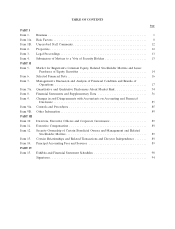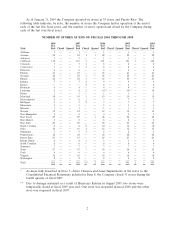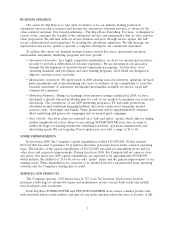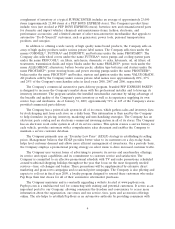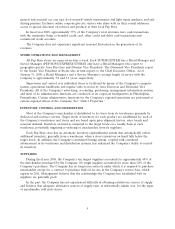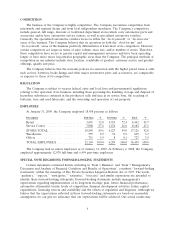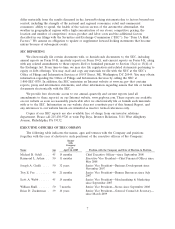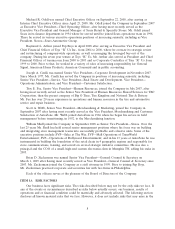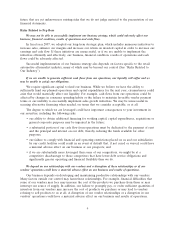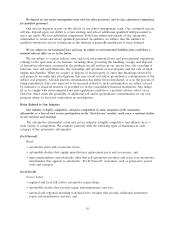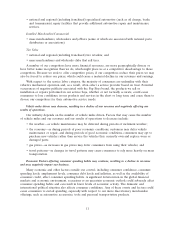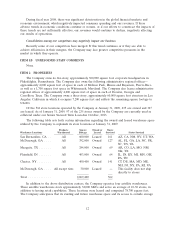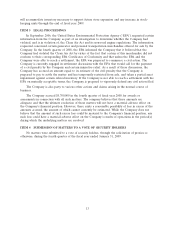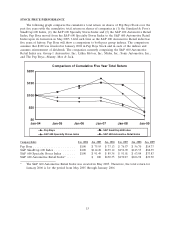Pep Boys 2008 Annual Report Download - page 70
Download and view the complete annual report
Please find page 70 of the 2008 Pep Boys annual report below. You can navigate through the pages in the report by either clicking on the pages listed below, or by using the keyword search tool below to find specific information within the annual report.
COMPETITION
The business of the Company is highly competitive. The Company encounters competition from
nationwide and regional chains and from local independent merchants. The Company’s competitors
include general, full range, discount or traditional department stores which carry automotive parts and
accessories and/or have automotive service centers, as well as specialized automotive retailers.
Generally, the specialized automotive retailers focus on either the ‘‘do-it-yourself’’ or ‘‘do-it-for-me’’
areas of the business. The Company believes that its operation in both the ‘‘do-it-for-me’’ and
‘‘do-it-yourself’’ areas of the business positively differentiates it from most of its competitors. However,
certain competitors are larger in terms of sales volume, store size, and/or number of stores. Therefore,
these competitors have access to greater capital and management resources and have been operating
longer or have more stores in particular geographic areas than the Company. The principal methods of
competition in our industry include store location, availability of product, customer service and product
offerings, quality and price.
The Company believes that the warranty policies in connection with the higher priced items it sells,
such as tires, batteries, brake linings and other major automotive parts and accessories, are comparable
or superior to those of its competitors.
REGULATION
The Company is subject to various federal, state and local laws and governmental regulations
relating to the operation of its business, including those governing the handling, storage and disposal of
hazardous substances contained in the products it sells and uses in its service bays, the recycling of
batteries, tires and used lubricants, and the ownership and operation of real property.
EMPLOYEES
At January 31, 2009, the Company employed 18,458 persons as follows:
Description Full-time % Part-time % Total %
Retail .......................... 3,891 32.0 4,551 72.4 8,442 45.7
Service Center .................... 7,008 57.6 1,676 26.6 8,684 47.1
STORE TOTAL .................. 10,899 89.6 6,227 99.0 17,126 92.8
Warehouses ...................... 555 4.5 54 0.9 609 3.3
Offices ......................... 715 5.9 8 0.1 723 3.9
TOTAL EMPLOYEES .............. 12,169 100.0 6,289 100.0 18,458 100.0
The Company had no union employees as of January 31, 2009. At February 2, 2008, the Company
employed approximately 12,070 full-time and 6,494 part-time employees.
SPECIAL NOTE REGARDING FORWARD-LOOKING STATEMENTS
Certain statements contained herein, including in ‘‘Item 1 Business’’ and ‘‘Item 7 Management’s
Discussion and Analysis of Financial Condition and Results of Operations’’, constitute ‘‘forward-looking
statements’’ within the meaning of The Private Securities Litigation Reform Act of 1995. The words
‘‘guidance,’’ ‘‘expects,’’ ‘‘anticipates,’’ ‘‘estimates,’’ ‘‘forecasts’’ and similar expressions are intended to
identify these forward-looking statements. Forward-looking statements include management’s
expectations regarding implementation of its long-term strategic plan, future financial performance,
automotive aftermarket trends, levels of competition, business development activities, future capital
expenditures, financing sources and availability and the effects of regulation and litigation. Although we
believe that the expectations reflected in these forward-looking statements are based on reasonable
assumptions, we can give no assurance that our expectations will be achieved. Our actual results may
6






